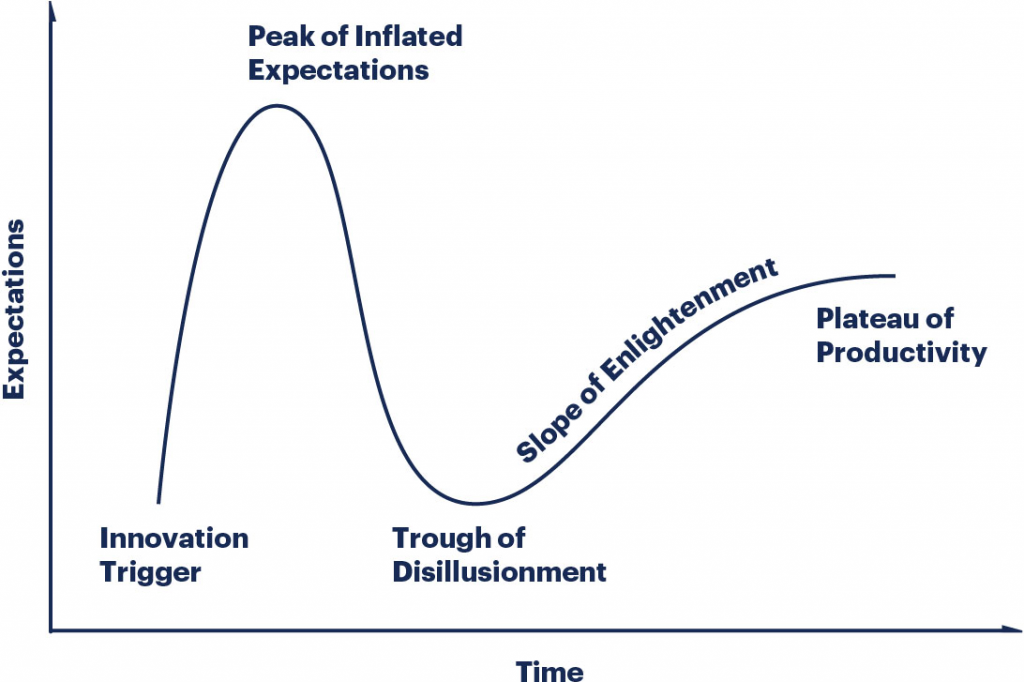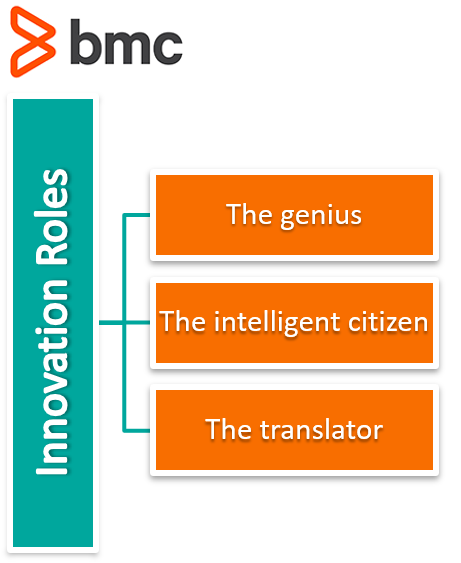And it begins. A spark. A possibility like no other. Only in pieces. Fragments. Like watching the neurons of your brain fire, illuminate, connect. You collect all the things you think you’ve ever known. You predict what can be based on what is, what isn’t, and what was.
It’s time to build.
This is the innovation trigger—the idea that could propel a new product, a new approach. Let’s take a look at this phase of product development.
What is the innovation trigger?
The innovation trigger is the first of five phases that comprise the Gartner Hype Cycle. A leading IT analyst and research group, Gartner tracks and visualizes the perceived value of a new technology innovation or trend, helping companies determine whether (and when) to embrace or bypass a given product.

(Source)
As the first stage in the development of any technology, the innovation trigger is a period with a lot of shoulds: a widget that should be, a service that should help, an idea that should exist. It is a period with not a lot more to go on than people’s dreams. The technology often lacks a product or market viability.
This phase is characterized by:
- An idea
- Lack of product or market viability
- Explanations about how great the product could be
- Excitement
- Creativity
The innovator’s tale
Ideas are easy to come by. They pop into the mind as a response to reading a news article, sitting in a classroom, conversing with another human being. There exists an idea every time one speaks. They think, “I have an idea how to respond to that statement.”
Good ideas, however, are hard to come by—and even harder to speak and bring to life. The intention of speaking is often to be understood, and good ideas are not often simple to understand. Good ideas can require a lot more explanation than any normal statement. “It is a beautiful day outside” is a much simpler idea than “People are all designers of language”. If the intention is to be understood, then the speaker will find more success with the first statement than the second.
If the intention was to be understood, no one would become an innovator.
Innovators, who wish to have good ideas and who wish to be understood, suffer. They have options to make the process easier, but they still face a dilemma. If they wish to be understood, they can surround themselves with people who already understand. But, nothing would be innovated if everyone already understood. The innovator is demoted to a parrot.
To the innovator, speaking to a room full of people who understand is no different than existing only in his own mind. Thus, there’s a degree to understanding. They can speak to people who understand 90% and the innovator will take them the rest of the 10%. They can speak to people who understand 30% and try to get the person the other 70%. Adjustments to direct communication or symbolic communication are made when speaking to each crowd.
To help be understood, the innovator can utilize the age-old art of rhetoric and argumentation. The innovator needs to build a case to support his idea. He can gather evidence. Evidence helps the innovator have other things speak for him. Suddenly, the innovator appeals to logic, and logic allows for new ideas to be good, right, ideas.
Eventually, after battle-testing the idea long enough against research and a bewildered audience, an innovator can learn what tactics to employ to communicate their idea.
“It’s not a joke until an audience laughs.” – Dave Attell
In its first stages, a product cannot exist on its own. It needs people behind it, who want to make it and who want to use it. Innovating is a difficult job. Few embrace its challenges. The marketplace of ideas is vast and plenty. There are few pockets worth anything.
Building an innovation team
A new technology must have a good team. New ideas need to propagate. And, with no product or market viability, the technology only exists through a public consciousness via word-of-mouth.
In Bluebeard, Kurt Vonnegut said people generally do not like new ideas, and a special team of three is needed. He said:
Most people cannot open their minds to new ideas unless a mind-opening team with a peculiar membership goes to work on them. The team must consist of three sorts of specialists, otherwise, the revolution, whether in politics or the arts or the sciences or whatever, is sure to fail:
The rarest of these specialists is an authentic genius.
The second sort of specialist is a lot easier to find: a highly intelligent citizen in good standing in his or her community, who understands and admires fresh ideas of the genius, and testifies that the genius is far from mad.
The third sort of specialist is a person who can explain anything, no matter how complicated, to the satisfaction of most people.
New technologies go about gathering these innovation teams.

The genius is someone, or several people, who diligently puts all the pieces together. Part of what makes them a genius is their mystery, so I do little for him with explanation.
The intelligent citizens, now, are the members of the community who have built-in reputation. They are often older and have a reputation among peers for the work they have done, or their outstanding contributions to the community. These people are your businessmen, community leaders, religious council, scholars. There exist people with reputations everywhere.
Finally, the third member of the team is the one who makes the complicated simple—a translator of sorts. This is largely the role of a marketing or advertising company, who can take a large, genius idea and boil it down to a three-word slogan or tagline: Just do it. Think different. Or we can look at company mission statements:
- “Uber’s mission is to bring transportation—for everyone, everywhere.”
- “SpaceX designs, manufactures and launches advanced rockets and spacecraft.”
Product viability
Products in this stage are unrefined. They look like wireframes. They are short, code mock-ups in a Jupyter notebook. They might even get to have a simple product set up.
The good technologies are usually promoted by individuals just as unrefined. If the promoter is refined, with nice shoes, smile, and a handshake, then there’s reason to be skeptical about why there is so much patina, and so little product.
This phase has promoters pointing at pieces of paper saying, “Once people use it, it should work like this.” They can create business plans that say, “The business should look like this.” They can make financial statements that say, “The numbers should look like this.”
Products in the phase of the Innovation Trigger exist on shoulds. If there are enough people behind this should, perhaps it can grow beyond its infancy and graduate into adolescence. The product has a long way to go before it stands tall amongst the crowd as its own. The idea’s next stop, if it can make it? The Peak of Inflated Expectations.
The Gartner Hype Cycle
Explore every phase of hype:
- The Innovation Trigger
- The Peak of Inflated Expectations
- Trough of Disillusionment
- Slope of Enlightenment
- Plateau of Productivity
Additional resources
For more on product development and innovation, browse our many articles or check out these resources:
- DevOps Guide
- BMC DevOps Blog
- BMC Business of IT Blog
- The Software Development Lifecycle (SDLC): An Introduction
- Guide to IT Leadership & Best Practices
These postings are my own and do not necessarily represent BMC's position, strategies, or opinion.
See an error or have a suggestion? Please let us know by emailing blogs@bmc.com.






